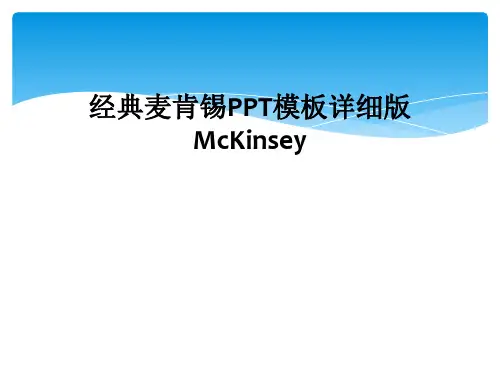麦肯锡英文介绍PPT
- 格式:ppt
- 大小:180.50 KB
- 文档页数:8

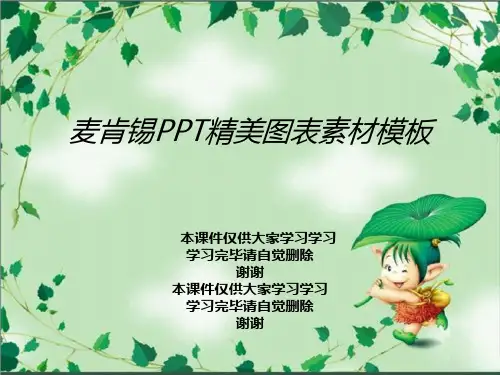

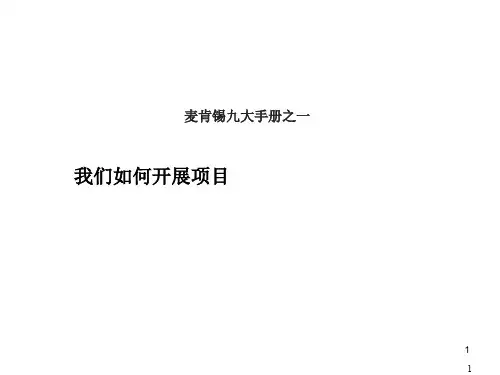
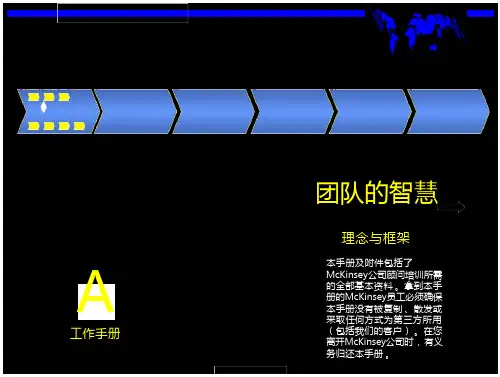



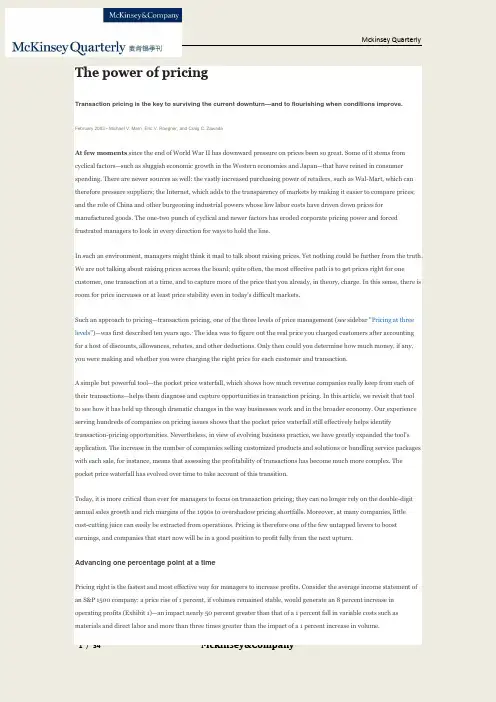
The power of pricingTransaction pricing is the key to surviving the current downturn—and to flourishing when conditions improve. February 2003 • Michael V. Marn, Eric V. Roegner, and Craig C. ZawadaAt few moments since the end of World War II has downward pressure on prices been so great. Some of it stems from cyclical factors—such as sluggish economic growth in the Western economies and Japan—that have reined in consumer spending. There are newer sources as well: the vastly increased purchasing power of retailers, such as Wal-Mart, which can therefore pressure suppliers; the Internet, which adds to the transparency of markets by making it easier to compare prices; and the role of China and other burgeoning industrial powers whose low labor costs have driven down prices for manufactured goods. The one-two punch of cyclical and newer factors has eroded corporate pricing power and forced frustrated managers to look in every direction for ways to hold the line.In such an environment, managers might think it mad to talk about raising prices. Yet nothing could be further from the truth. We are not talking about raising prices across the board; quite often, the most effective path is to get prices right for one customer, one transaction at a time, and to capture more of the price that you already, in theory, charge. In this sense, there is room for price increases or at least price stability even in today's difficult markets.Such an approach to pricing—transaction pricing, one of the three levels of price management (see sidebar "Pricing at three levels")—was first described ten years ago.1 The idea was to figure out the real price you charged customers after accounting for a host of discounts, allowances, rebates, and other deductions. Only then could you determine how much money, if any, you were making and whether you were charging the right price for each customer and transaction.A simple but powerful tool—the pocket price waterfall, which shows how much revenue companies really keep from each of their transactions—helps them diagnose and capture opportunities in transaction pricing. In this article, we revisit that toolto see how it has held up through dramatic changes in the way businesses work and in the broader economy. Our experience serving hundreds of companies on pricing issues shows that the pocket price waterfall still effectively helps identify transaction-pricing opportunities. Nevertheless, in view of evolving business practice, we have greatly expanded the tool's application. The increase in the number of companies selling customized products and solutions or bundling service packages with each sale, for instance, means that assessing the profitability of transactions has become much more complex. The pocket price waterfall has evolved over time to take account of this transition.Today, it is more critical than ever for managers to focus on transaction pricing; they can no longer rely on the double-digit annual sales growth and rich margins of the 1990s to overshadow pricing shortfalls. Moreover, at many companies, littlecost-cutting juice can easily be extracted from operations. Pricing is therefore one of the few untapped levers to boost earnings, and companies that start now will be in a good position to profit fully from the next upturn.Advancing one percentage point at a timePricing right is the fastest and most effective way for managers to increase profits. Consider the average income statement of an S&P 1500 company: a price rise of 1 percent, if volumes remained stable, would generate an 8 percent increase in operating profits (Exhibit 1)—an impact nearly 50 percent greater than that of a 1 percent fall in variable costs such as materials and direct labor and more than three times greater than the impact of a 1 percent increase in volume.Unfortunately, the sword of pricing cuts both ways. A decrease of 1 percent in average prices has the opposite effect, bringing down operating profits by that same 8 percent if other factors remain steady. Managers may hope that higher volumes will compensate for revenues lost from lower prices and thereby raise profits, but this rarely happens; to continue our examination of typical S&P 1500 economics, volumes would have to rise by 18.7 percent just to offset the profit impact of a 5 percent price cut. Such demand sensitivity to price cuts is extremely rare. A strategy based on cutting prices to increase volumes and, as a result, to raise profits is generally doomed to failure in almost every market and industry.Following the pocket price waterfallMany companies can find an additional 1 percent or more in prices by carefully looking at what part of the list price of a product or service is actually pocketed from each transaction. Right pricing is a more subtle game than setting list prices or even tracking invoice prices. Significant amounts of money can leak away from list or base prices as customers receive discounts, incentives, promotions, and other giveaways to seal contracts and maintain volumes (see sidebar "A hole in your pocket").The experience of a global lighting supplier shows how the pocket price—what remains after all discounts and other incentives have been tallied—is usually much lower than the list or invoice price. This company made incandescent lightbulbs and fluorescent lights sold to distributors that then resold them for use in offices, factories, stores, and other commercial buildings. Every lightbulb had a standard list price, but a series of discounts that were itemized on each invoice pushed average invoice prices 32.8 percent lower than the standard list prices. These on-invoice deductions included the standard discounts given to most distributors as well as special discounts for selected ones, discounts for large-volume customers, and discounts offered during promotions.Managers who oversee pricing often focus on invoice prices, which are readily available, but the real pricing story goes much further. Revenue leaks beyond invoice prices aren't detailed on invoices. The many off-invoice leakages at the lighting company included cash discounts for prompt payment, the cost of carrying accounts receivable, cooperative advertising allowances, rebates based on a distributor's total annual volume, off-invoice promotional programs, and freight expenses. In the end, the company's average pocket price—including 16.3 percentage points in revenue reductions that didn't appear on invoices—was about half of the standard list price (Exhibit 2a). Over the past decade, companies have tried to entice buyerswith a growing number of discounts, including discounts for on-line orders as well as the increasingly popular performance penalties that require companies to provide a discount if they fail to meet specific performance commitments such as on-time delivery and order fill rates.By consciously and assiduously managing all elements of the pocket price waterfall, companies can often find and capture an additional 1 percent or more in their realized prices. Indeed, an adjustment of any discount or element along the waterfall—either on- or off-invoice—is capable of improving prices on a transaction-by-transaction basis.Embracing a wide bandThe pocket price waterfall is often first created as an average of all transactions. But the amount and type of the discounts offered may differ from customer to customer and even order to order, so pocket prices can vary a good deal. We call the distribution of sales volumes over this range of variation the pocket price band.At the lighting company, some bulbs were sold at a pocket price of less than 30 percent of the standard list price, others at 90 percent or more—three times higher than those of the lowest-priced transactions (Exhibit 2b). This range may seem spectacular, but it is not very unusual. In our work, we have seen pocket price bands in which the highest pocket price was five or six times greater than the lowest.A wide band shows that certain customers generate much higher pocket prices than do othersIt would be a mistake, though, to assume that wide pocket price bands are necessarily bad. A wide band shows that neither all customers nor all competitive situations are the same—that for a whole host of reasons, some customers generate much higher pocket prices than do others. When a band is wide, small changes in its shape can readily move the average price a percentage point or more higher. If a manager can increase sales slightly at the high end of the band while improving or even dropping transactions at the low end, such an increase comes within reach. But when the price band is narrow, the manager has less room to maneuver; changing its shape becomes more difficult; and any move has less impact on average prices.Although the lighting company was surprised by the width of its pocket price band, it had a quick explanation: the range resulted from a conscious effort to reward high-volume customers with deeper discounts, which in theory were justified notonly by the desire to court such customers but also by a lower cost to serve them. A closer examination showed that this explanation was actually wide of the mark (Exhibit 3): many large customers received relatively modest discounts, resulting in high pocket prices, while a lot of small buyers got much greater discounts and lower pocket prices than their size would warrant. A few smaller customers received large discounts in special circumstances—unusually competitive or depressed markets, for instance—but most just had long-standing ties to the company and knew which employees to call for extra discounts, additional time to pay, or more promotional money. These experienced customers were working the pocket price waterfall to their advantage.The lighting company attacked the problem from three directions. First, it instructed its sales force to bring into line—or drop—the smaller distributors getting unacceptably high discounts. Within 12 months, 85 percent of these accounts were being priced and serviced in a more appropriate way, and new accounts had replaced most of the remainder. Second, the company launched an intensive program to stimulate sales at larger accounts for which higher pocket prices had been realized. Finally, it controlled transaction prices by initiating stricter rules on discounting and by installing IT systems that could track pocket prices more effectively. In the first year thereafter, the average pocket price rose by 3.6 percent and operating profits by 51 percent.In addition to these immediate fixes, the lighting company took longer-term measures to change the relationship between pocket prices and the characteristics of its accounts. New and explicit pocket price targets were based on the size, type, and segment of each account, and whenever a customer's prices were renegotiated or a new customer was signed, that target guided the negotiations.Pocket margins become more relevantFor companies that not only sell standard products and services but also experience little variation in the cost of selling and delivering them to different customers, pocket prices are an adequate measure of price performance. Today, however, as companies seek to differentiate themselves amid growing competition, many are offering customized products, bundling product and service packages with each sale, offering unique solutions packages, or providing unique forms of logistical andtechnical support. Pocket prices don't capture these different product costs or the cost to serve specific customers. For such companies, another level of analysis—the pocket margin—is needed to reflect the varying costs associated with each order. The pocket margin for a transaction is calculated by subtracting from the pocket price any direct product costs and costs incurred specifically to serve an individual account.One North American company, which manufactures tempered glass for heavy trucks and for farm and construction machinery, sharply increased its profits by understanding and actively managing its pocket margins. Each piece of the company's glass was custom-designed for a specific customer, so costs varied transaction by transaction. Other costs differed from customer to customer as well. The company's glass, for example, was frequently shipped in special containers that were designed to be compatible with the customers' assembly machines. The costs of retooling and other customer-specific services varied widely from case to case but averaged no less than 17 percent of the target base price (Exhibit 4a).A fuller picture emerges when a company examines each account and creates a pocket margin bandAs with pocket prices, a fuller picture emerges when a company examines each account and creates a pocket margin band. The glass company's pocket margins ranged from more than 60 percent of base prices to a loss of more than 15 percent of base prices (Exhibit 4b). When fixed costs were allocated, the company found that it required a pocket margin of at least 12 percent just to break even at the current operating level. More than a quarter of the company's sales fell below this threshold.Traditionally, the pricing policies of the glass company had focused on invoice prices and standard product costs; it paid little attention to off-invoice discounts or extra costs to serve specific customers. The pocket margin band helped it identify which individual customers were more profitable and which should be approached more aggressively even at the risk of losing their business. The company also uncovered narrowly defined customer segments (for example, medium-volume buyers of flat or single-bend door glass) that were concentrated at the high end of the margin band. In addition, it evaluated its policies for some of the more standard waterfall elements to ensure that it had clear objectives, accountability, and controls for each of them—for instance, it decided to base volume bonuses on stretch performance targets and to charge for last-minute technical support. By focusing on and increasing sales in profitable subsegments, pruning less attractive accounts, and making selective policy changes across the waterfall elements, the company pushed up its average pocket margin by 4 percent and its operating profits by 60 percent within a year.Taming transactionsThe game of transaction pricing is won or lost in hundreds, sometimes thousands, of individual decisions each day. Standard and discretionary discounts allow percentage points of revenue to drop from the table one transaction at a time. Companies are often poorly equipped to track these losses, especially for off-invoice items; after all, the volumes and complexity of transactions can be overwhelming, and many items, such as cooperative advertising or freight allowances, are accounted for after the fact or on a company-wide basis. Even if managers wanted to track transaction pricing, it has often been impossible to get the data for specific customers or transactions. But some recent technical advances have helped remove this obstacle; enterprise-management-information systems and off-the-shelf custom-pricing software have made it easier to keep tabs on transaction pricing. Managers can no longer hide behind the excuse that gathering the data is too difficult.Current price pressures should go a long way toward removing two other obstacles: will and skill. In the booming economy of the 1990s, robust demand and cost-cutting programs, which drove up corporate earnings, made too many managers pay too little attention to pricing. But now that a global economic downturn has slowed growth and the easiest cost cutting has already occurred, the shortfall in pricing capabilities has been exposed. A large number of companies still don't understand the untapped opportunity that superior transaction pricing represents. For many companies, getting it right may be one of the keys to surviving the current downturn and to flourishing when the upturn arrives. It has never been more crucial—ormore possible—to learn and apply the skills needed to execute superior transaction-price management.Pricing at three levelsTransaction pricing is one of three levels of price management. Although distinct, each level is related to the others, and action at any one level could easily affect the others as well. Businesses trying to obtain a price advantage—that is, to make superior pricing a source of distinctive performance—must master all three of these levels.Industry price level. The broadest view of pricing comes at the industry price level, where managers must understand how supply, demand, costs, regulations, and other high-level factors interact and affect overall prices. Companies that excel at this level avoid unnecessary downward pressure on prices and often emerge as industry price leaders.Product/market strategy level. The primary issue at this second level is pricing a product or service relative to the competition. To do so, companies must understand how customers perceive all offerings on the market and, most particularly, which attributes—product as well as service and intangible attributes—drive purchase decisions. With this knowledge, companies can set visible list prices that accurately reflect the competitive strengths (or weaknesses) of their offerings.Transaction level. The focus of transaction pricing is to decide the exact price for each transaction—starting with the list price and determining which discounts, allowances, payment terms, bonuses, and other incentives should be applied. For a majority of companies, the management of transaction pricing is the most detailed, time-consuming, systems-intensive, andenergy-intensive task involved in gaining a price advantage.A hole in your pocketMany on- and off-invoice items can easily lead to price and margin leaks. Here we provide a nonexhaustive list:Annual volume bonus: an end-of-year bonus paid to customers if preset purchase volume targets are met.Cash discount: a deduction from the invoice price if payment for an order is made quickly, often within 15 days. Consignment cost: the cost of funds when a supplier provides consigned inventory to a wholesaler or retailer.Cooperative advertising: an allowance paid to support local advertising of the manufacturer’s brand by a retailer or wholesaler.End-customer discount: a rebate paid to a retailer for selling a product to a specific customer—often a large or national one—at a discount.Freight: the cost to the company of transporting goods to the customer.Market-development funds: a discount to promote sales growth in specific segments of a market.Off-invoice promotions: a marketing incentive that would, for example, pay retailers a rebate on sales during a specific promotional period.On-line order discount: a discount offered to customers ordering over the Internet or an intranet.Performance penalties: a discount that sellers agree to give buyers if performance targets, such as quality levels or delivery times, are missed.Receivables carrying cost: the cost of funds from the moment an invoice is sent until payment is received.Slotting allowance: an allowance paid to retailers to secure a set amount of shelf space.Stocking allowance: a discount paid to wholesalers or retailers to make large purchases into inventory, often before a seasonal increase in demand.The challenges ahead for supply chains: McKinsey Global Survey resultsSenior executives say their companies manage key trade-offs well, yet see barriers to better performance: rising risk, lack of collaboration, and low CEO involvement.As economies around the world step back from the financial brink and begin adjusting to a new normal, companies face a different set of supply chain challenges than they did at the height of the downturn—among them are rising pressure from global competition, consumer expectations, and increasingly complex patterns of customer demand. Executives in this McKinsey survey1are divided on their companies’ preparedness to meet those challenges, and fully two-thirds expect supply chain risk to increase. What’s more, the survey highlights troubling signs of struggle associated with key, underlying supply chain processes and capabilities, including the ability of different functions to collaborate, the role of CEOs in supply chain planning, and the extent to which companies gather and use information.Emerging from the downturnAs companies have managed their supply chains over the past three years, the challenges they faced and the goals they set have reflected a single-minded focus on weathering the financial crisis. The most frequently cited challenge of the past three years is the increasing volatility of customer demand (Exhibit 1). This is no doubt a result of the sharp drop in consumer spending that has reverberated throughout all sectors across the globe. Looking at challenges over the next five years, though, the focus shifts: respondents most frequently cite increasing pressure from global competition. Some issues that receive a lot of public attention, such as climate change and natural-resource use, have remained a low priority since our 2008 survey.2 Still, the share that identify environmental concerns as a top challenge in the next five years nearly doubled, to 21 percent, over the proportion saying it was a top challenge during the past three years. This suggests that companies anticipate returning to a new normal,3 wherein they can focus on issues other than cost at least some of the time.With regard to goals for supply chain management, the results show a similar shift between past and future, perhaps another indicator that companies are focusing on pursuing growth in addition to cost containment (Exhibit 2). Of course, executives are not ignoring supply chain costs altogether; after weathering a downturn, they know their companies can manage and control future expenses, now that this issue has been on their radar consistently. Indeed, reducing operating costs remains the most frequently chosen goal over the next five years—as it was over the past three—followed by customer service. In a 2008 survey, 43 percent of respondents said improving service was one of their companies’ top two goals for supply chain management, and though it fell as a priority during the crisis, it is now number two for the next five years.Executives also indicate that many of their companies have met past goals, with supply chain performance improving in both efficiency and effectiveness as they come out of the downturn. For example, nearly half say th eir companies’ service levels are higher now than they were three years ago, 39 percent say costs as a percentage of sales are lower, and 45 percent have cut inventories.What hasn’t changed much, though, is the amount of supply chain risk that executives foresee (Exhibit 3). More thantwo-thirds say risk increased in the past three years, and nearly the same share see risk continuing to rise. Respondents in developed Asian countries report more concern than those in any other region: 82 percent say their c ompanies’ supply chain risk will increase in the next five years.4Managing challenges and trade-offsThough the strategic goals executives are setting suggest a hope that more predictable business conditions will prevail over the next five years, respondents are divided over how well their companies can manage the challenges (Exhibit 4). This finding holds true for large and small companies alike and among executives in different functions.The good news is that on the three challenges cited most frequently (global competition, rising consumer expectations, and complex patterns of customer demand), the highest shares of executives say their companies are prepared to meet those challenges. The bad news is that the shares saying their companies are well prepared are still below half.Most executives recognize the importance of managing the functional trade-offs related to these challenges and think that their companies are effective at doing so. Among trade-offs, the highest share of respondents—85 percent—say balancing cost to serve and customer service is important to their companies’ supply chain strategy. The lowest share (59 percent) say balancing centralized production against proximity to customers is important. Respondents also report that the managers who make decisions about supply chain trade-offs are well informed.Yet the cross-functional discussions that companies need if they are to make informed decisions are not happening often. For each of the six trade-offs the survey explored, regular cross-functional meetings are cited as the most common process for making decisions, but between 31 and 40 percent of respondents say their operations teams never or rarely meet with salesand marketing to discuss supply chain tensions. Furthermore, respondents across functions say sales/marketing has the most difficulty collaborating with other functions, with 23 percent citing a problem between that group and manufacturing, and 21 percent between it and planning. Additionally, one-third of respondents say the biggest barrier to collaborating when managing trade-offs is that functional areas don’t understand their impact on others.This disconnection is likely exacerbated by the relatively low levels of CEO involvement reported: the vast majority of CEOs do not actively develop supply chain strategy or work hands-on to execute it (Exhibit 5). Respondents do, however, expect more CEO involvement over the next five years—a hopeful sign for companies aspiring to mend key cross-functional disconnections.Knowledge is powerThe results show a similar disconnection between data and decision making: companies seem to collect and use much less detailed information than our experience suggests is prudent in making astute supply chain decisions (Exhibit 6). For example, customer service is becoming a higher priority, and executives say their companies balance service and cost to serve effectively, yet companies are most likely to take a one-size-fits-all approach when defining and managing service-level targets. Half of the executives say their companies have limited or no quantitative information about incremental costs for raw materials, manufacturing capacity, and personnel, and 41 percent do not track per-customer supply chain costs at any useful level of detail.Many of the future supply chain challenges will require companies to keep better information on individual costs and customers. Yet only about a quarter of respondents expect their companies will invest in IT systems over the next five years, and only 10 percent of respondents say their companies currently use social media to identify customers’ service needs.Looking ahead∙In our experience, senior-executive involvement, including hands-on attention from the CEO, is pivotal in managing the cross-functional trade-offs that underpin many supply chain decisions. Yet the role of CEOs at many companies we surveyed is limited or nonexistent. Companies that can bridge the functional divides that thwart collaboration will have an edge in creating competitive supply chains capable of fulfilling business strategy requirements.∙Addressing the challenges companies have identified—improving service and responding to new expectations and patterns of customer demand—requires more and better information, regardless of the geographical scope or the length of supply chains.As the marketplace becomes increasingly fragmented, keeping better track of customer information and costs, which can inform and support interpersonal, cross-functional discussions, will help companies prepare for the supply chainuncertainties that lie ahead.∙Despite the importance of volatile commodity prices as a supply chain challenge, just 28 percent of respondents say their companies are prepared to manage that volatility. One way to cope with this uncertainty: view supply chain assets as a hedge.By considering investment in production resources that aren’t necessarily lowest-cost today (but soon could be), companies can position themselves for greater flexibility in the future.∙Executives expect environmental concerns to be a more significant issue for supply chains in the years ahead, yet relatively few consider it a priority today. Given that up to 60 percent of a company’s carbon footprint can reside upstr eam in its supply chain,5 companies would be wise to pursue economically attractive opportunities that address environmental impact in the near term and prepare to respond quickly to any sudden shifts in environmental expectations and requirements.A new idea in banking for the poorBy teaming up with retail outlets in low-income, often hard-to-reach areas, financial institutions can create value both for themselves and their new customers.November 2010 • Alberto Chaia, Robert Schiff, and Esteban Silva。

